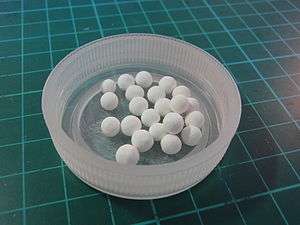Activated alumina

Activated alumina is manufactured from aluminium hydroxide by dehydroxylating it in a way that produces a highly porous material; this material can have a surface area significantly over 200 m²/g. The compound is used as a desiccant (to keep things dry by absorbing water from the air) and as a filter of fluoride, arsenic and selenium in drinking water. It is made of aluminium oxide (alumina; Al2O3), the same chemical substance as sapphire and ruby (but without the impurities that give those gems their color). It has a very high surface-area-to-weight ratio, due to the many "tunnel like" pores that it has .
Uses
Catalyst applications
Activated alumina is used for a wide range of adsorbent and catalyst applications including the adsorption of catalysts in polyethylene production, in hydrogen peroxide production, as a selective adsorbent for many chemicals including arsenic, fluoride, in sulphur removal from gas streams (Claus Catalyst process).
Desiccant
Used as a desiccant, it works by a process called adsorption. The water in the air actually sticks to the alumina itself in between the tiny passages as the air passes through them. The water molecules become trapped so that the air is dried out as it passes through the filter. This process is reversible. If the alumina desiccant is heated to ~200 °C, it will release the trapped water. This process is called regenerating the desiccant.
Fluoride adsorbent
Activated alumina is also widely used to remove fluoride from drinking water. In the US, there are widespread programs to fluoridate drinking water. However, in certain regions, such as the Rajasthan region of India, there is enough fluoride in the water to cause fluorosis. A study from the Harvard school of Public Health found exposure to fluoride as a child correlated with lower IQ.[1]
Activated alumina filters can easily reduce fluoride levels from 10.0 ppm to less than 1.0 ppm. The amount of fluoride leached from the water being filtered depends on how long the water is actually touching the alumina filter media. Basically, the more alumina in the filter, the less fluoride will be in the final, filtered water. Lower temperature water, and lower pH water (acidic water) are filtered more effectively too. Ideal pH for treatment is 5.5, which allows for up to a 95% removal rate.
As per researches conducted by V.K.Chhabra {Chief Chemist (retd.) P.H.E.D.Raj.} Activated alumina, when used as a fluoride filter, under field conditions can best be regenerated by a solution of lye (sodium hydroxide; NaOH), sulphuric acid (H2SO4). The fluoride uptake capacity (FUC) of activated alumina can be up to 5000 mg/kg. The FUC can be determined as follows:
V.K.Chhabra’s method (Chief Chemist retired, PHED Raj., India): Fluoride solution: Dissolve 22.1 g anhydrous NaF in distilled water and dilute to 1,000 mL. 1 mL = 10 mg fluoride. 10 mL/L = 100 mg/L fluoride.
Procedure: To one litre of simulated distilled water containing 100 mg/L of fluoride, agitate at 100 rpm using the jar test machine. Add 10 g of the AA under test. After one hour, switch off the machine and take out the solution. After 5 minutes, carefully decant the supernatant solution and determine the fluoride. Calculate the difference between the original and treated water fluoride concentration. Multiply the difference by 100 to give the fluoride uptake capacity of AA in mg/kg.
Vacuum systems
In high vacuum applications, activated alumina is used as a charge material in fore-line traps to prevent oil generated by rotary vane pumps from back streaming into the system.[2]
Biomaterial
Its mechanical properties and non-reactivity in the biological environment allow it to be a suitable material used to cover surfaces in friction in body prostheses (e.g. hip or shoulder prostheses).
See also
References
- ↑ "Developmental Fluoride Neurotoxicity: A Systematic Review and Meta-Analysis" (PDF).
- ↑ Ronald Vane. "Reducing Oil Back streaming in Electron Microscopes".
1. Ms. Sunita Yadav, Ms. Dimple Sharma and Chhabra V.K. “Defluoridation with Activated Alumina”, J.IWWA, Vol.42 no.3, 210-213 2. Chhabra V.K., ”Chhabra’s method for determination of FUC of AA”.J.IWWA, Vol.39 No.3,225-229 3. Tender documents of PHED Raj. 4. Domestic defluoridation for drinking water using AA by Leela Iyengar and Raj Kumar Daw p-T-2(1) to T-2(6), National workshop on control & mitigation of excess fluoride in drinking water 5-7 Feb.,2004 at Jaipur organized by PHED Raj. & UNICEF. 5. Leaflet Bhargava Alumina Industries, Gujarat. 6. Ms. Savita, A.B.Gupta & Chhabra V.K. “Performance Analysis of Community Level Activated Alumina Defluoridation Plants in Dungarpur, Raj.” Journal Hydro 2008. 7. Ms. Sunita Yadav, Ms. Dimple Sharma and Chhabra V.K. “Innovative Technology for Defluoridation with Activated Alumina” 42nd annual convention of IWWA page 183-187 8. Jatin Chhabra & Chhabra V.K. “ Country’s first successful community defluoridation plant based on Activated Alumina” Jr.IWWA vol.38 no.1 page 31-36. 9. Fluorides in water AWWA 1971. 10. Operation & Control of water treatment processes by Charles R. Cox 1969. 11. CWC Publication no.27/88. Status report on evaporation control in reservoirs, Central Water Commission, New Delhi Feb. 1988 12. Water Treatment for Public & IndustriSupply by G.Nikoladze, Mir Publishers, 1989. 13. Xu Guo Xun “Fluoride removal from drinking water by AA” Aqua Vol.43 no.2 pp58–64 yr.1994. 14. Paper written by Dr. C. Venkobachar & Dr. Leela Iyengar IIT Kanpur for the workshop on Defluoridation of water using AA, 7-8th March1996 sponsored by UNICEF, New Delhi.